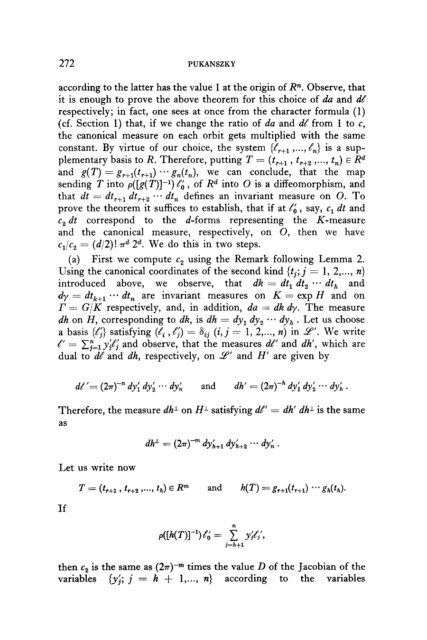On the Characters and the Plancherel Formula of Nilpotent Groups ...
On the Characters and the Plancherel Formula of Nilpotent Groups ...
On the Characters and the Plancherel Formula of Nilpotent Groups ...
You also want an ePaper? Increase the reach of your titles
YUMPU automatically turns print PDFs into web optimized ePapers that Google loves.
272 PUKANSZKY<br />
according to <strong>the</strong> latter has <strong>the</strong> value 1 at <strong>the</strong> origin <strong>of</strong> R”. Observe, that<br />
it is enough to prove <strong>the</strong> above <strong>the</strong>orem for this choice <strong>of</strong> da <strong>and</strong> dt<br />
respectively; in fact, one sees at once from <strong>the</strong> character formula (1)<br />
(cf. Section 1) that, if we change <strong>the</strong> ratio <strong>of</strong> da <strong>and</strong> d/from 1 to c,<br />
<strong>the</strong> canonical measure on each orbit gets multiplied with <strong>the</strong> same<br />
constant. By virtue <strong>of</strong> our choice, <strong>the</strong> system {8r+r ,..., tn,) is a sup-<br />
plementary basis to R. Therefore, putting T = (t,,, , tr+2 ,..., tn) E Rd<br />
<strong>and</strong> g(T) = gr+lPr+l) - g&J, we can conclude, that <strong>the</strong> map<br />
sending T into p([g( T)]-l) tfi , <strong>of</strong> Ra into 0 is a diffeomorphism, <strong>and</strong><br />
that dt = dt,,, dt,,, e.0 dt, defines an invariant measure on 0. To<br />
prove <strong>the</strong> <strong>the</strong>orem it suffices to establish, that if at /i , say, cr dt <strong>and</strong><br />
ca dt correspond to <strong>the</strong> d-forms representing <strong>the</strong> K-measure<br />
<strong>and</strong> <strong>the</strong> canonical measure, respectively, on 0, <strong>the</strong>n we have<br />
cl/cz = (d/2)! # 2d. We do this in two steps.<br />
(a) First we compute ce using <strong>the</strong> Remark following Lemma 2.<br />
Using <strong>the</strong> canonical coordinates <strong>of</strong> <strong>the</strong> second kind {ti;j = 1, 2,..., n}<br />
introduced above, we observe, that dk = dt, dt, *** dt, <strong>and</strong><br />
dr = d&+1 *a* dt, are invariant measures on K = exp H <strong>and</strong> on<br />
r = G/K respectively, <strong>and</strong>, in addition, da = dk dy. The measure<br />
dh on H, corresponding to dk, is dh = dy, dy, *** dyh . Let us choose<br />
a basis {ei} satisfying (e, , Cj) = aij (;,j = 1, 2,..., a) in 9’. We write<br />
d’ = ~Yryjr!~ <strong>and</strong> observe, that <strong>the</strong> measures dt!” <strong>and</strong> dh’, which are<br />
dual to dt <strong>and</strong> dh, respectively, on 9’ <strong>and</strong> H’ are given by<br />
a?!‘= (237)~” ay; fly; *-* ay; <strong>and</strong> dh’ = (23~)-~ dy; dy; .** dy; .<br />
Therefore, <strong>the</strong> measure dhl on HJ- satisfying de’ = dh’ dhl is <strong>the</strong> same<br />
as<br />
Let us write now<br />
If<br />
dhL = (24” dy;+, dy;+z ..* dy: .<br />
T = (b+l , t,+z ,..., t,J E Rm <strong>and</strong> W”) = g,+&+d a** g&d<br />
<strong>the</strong>n c2 is <strong>the</strong> same as (2n)-m times <strong>the</strong> value D <strong>of</strong> <strong>the</strong> Jacobian <strong>of</strong> <strong>the</strong><br />
variables (y;; j = h + l,..., n) according to <strong>the</strong> variables

















